Do you ever look at your scraggly, dandelion-strewn yard on a hot, humid day, knowing you should mow, but feeling like you just mowed yesterday? At that moment, you have a strong temptation to rip up the whole thing and replace it with a rock garden.
Here at Tussey Landscaping, we’ve been in the landscaping business for over thirty years, and we know how frustrating and tedious it can be to keep up with yard work.
But there’s good news! It’s possible to landscape in a way that substantially reduces the maintenance required.
Today, we’ll explore the world of low-maintenance landscaping, walking you through the philosophy behind it as well as some ideas for low-maintenance plants in Pennsylvania. By the end, you should have some great ideas for keeping your backyard beautiful and inviting while substantially reducing maintenance!
Let’s dig in!
Why Low-Maintenance Landscaping is Ideal for Pennsylvania Homeowners
If you’re like us, you probably have plenty to do in your free time!
The last thing you want to do is spend large amounts of time and money maintaining a perfectly pristine lawn. Between mowing, weeding, and watering, it’s a lot of work—and that work doesn’t always pay off. Sometimes you find that despite all your best efforts, your yard still has brown patches, your flowers wither and die, and weeds spring up unannounced from every crevice.
Low-maintenance landscaping offers a way to make your landscaping do it all—look beautiful, require much less work on your part, save money, and help the environment.
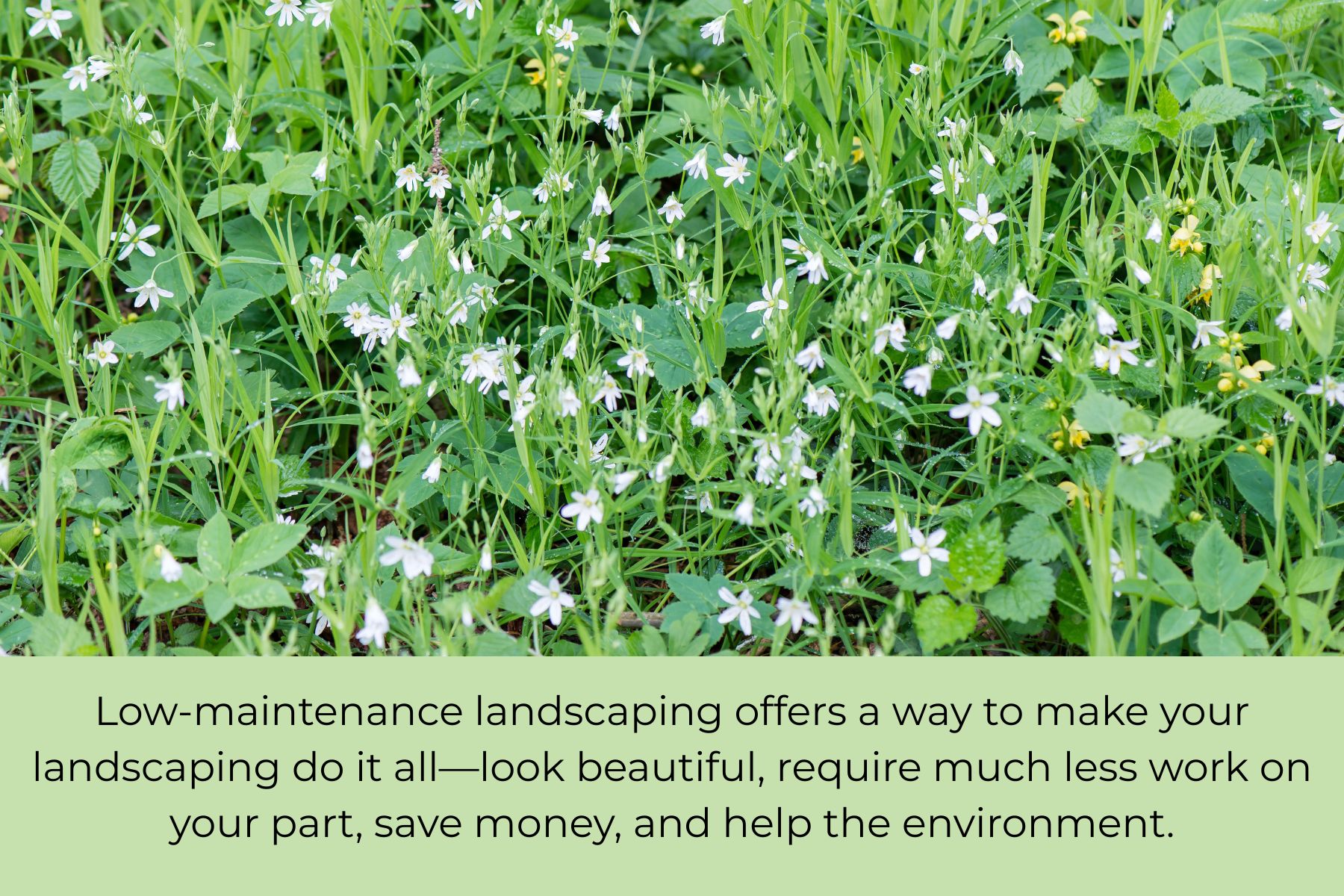
Of course, it’s not all sunshine and rainbows, and many low-maintenance options involve adjusting your expectations for how your landscape should look and function.
What Should My Lawn Look Like?
As a child, you may have played on lawns that were part grass, part clover, and part moss, sprinkled with dandelions, tiny daisies, and purple deadnettle. Perhaps the grass grew brown during the dry season and revived again when the rains returned.
Although the flowers, the ground cover diversity, and the browning-and-reviving cycle are all signs of ecosystem health, those are the very things people work hard to eliminate. After all, soft, pristine, vibrantly-green grass with nary a weed in sight has become a status symbol.
If you want to pursue low-maintenance landscaping, you first need to be willing to adjust your expectations for what landscaping should look like. When considering various options, ask yourself:
- Do I like the look of this, even if it’s not what I’m used to?
- Will this work for my family and lifestyle?
It’s also true that not every low-maintenance option will be a good fit. For example, a clover lawn might look lovely, but it attracts bees. This is great if you want to help local pollinators, but not so great if you want a place for your children to run and play without getting stung.
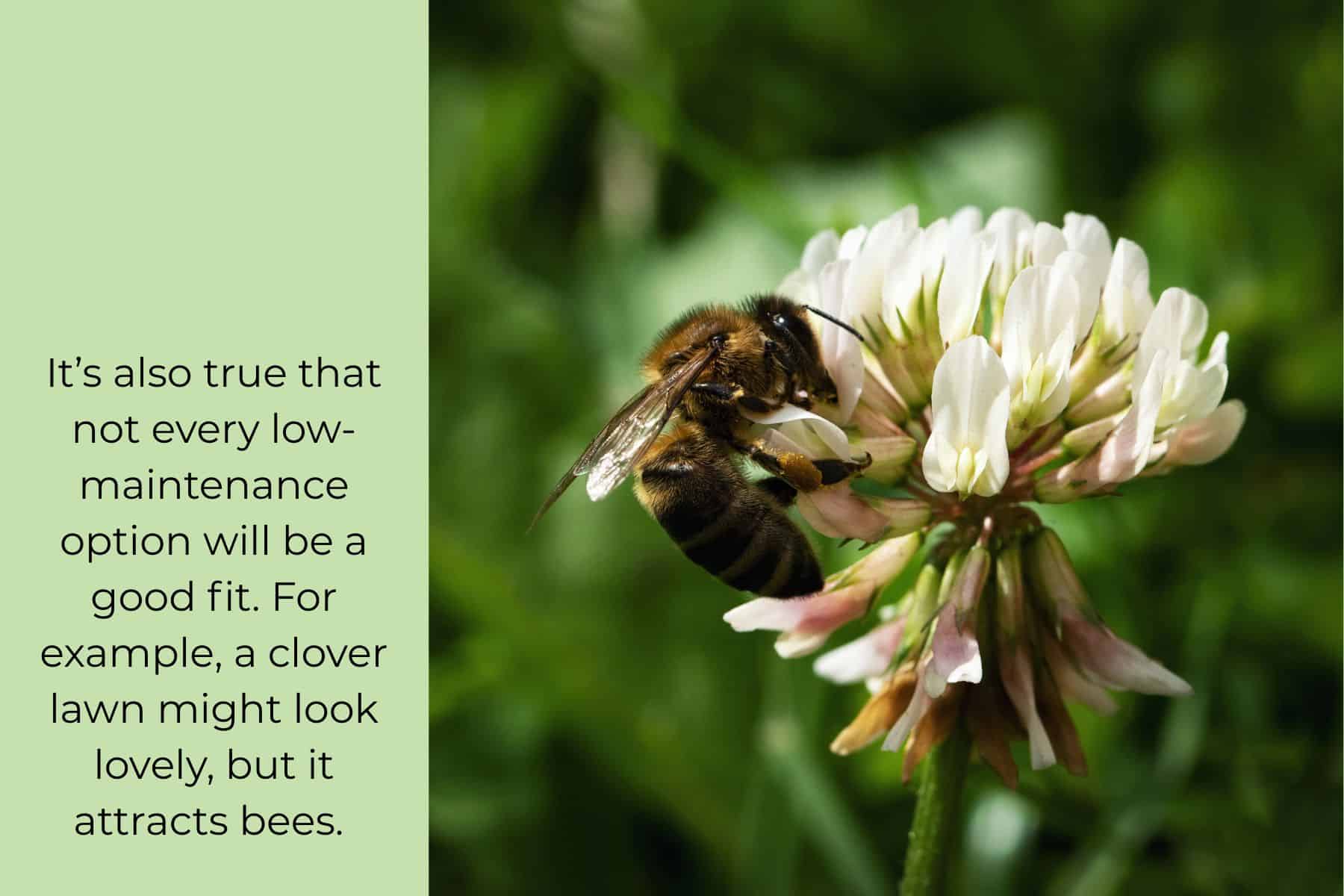
Other low-maintenance options, like a wildflower garden in place of a lawn, are breathtaking—but what will you do when you want to host a large party or your children want a place to kick a soccer ball?
But the range of options is vast, and there are solutions for every problem you might think of. For example, if you want space to host, a flagstone patio is a gorgeous option that’s infinitely less maintenance than a lawn. But before we get to solutions, let’s explore why those pristine, perfect lawns are so high-maintenance in the first place.
The Problem with Monocultures
If you can remember back to your third-grade science class, when you learned about ecosystems, you probably remember that various types of plants and animals interact with each other in ways that ultimately benefit each other and the environment as a whole.
For example, in a forest, tree roots hold the soil in place, preventing erosion, and their leaves make a canopy that keeps the forest cool. This allows other grasses, ferns, flowers, and fungi to thrive. Later, the plants will decompose into nutrients, and the fungi will help break down these nutrients, which will in turn help the trees thrive.
Because different plants interact with each other in this way, it’s tough for a monoculture to thrive. Maintaining and growing just one thing requires a great deal of labor. That’s why several indigenous tribes of North America farmed by planting the “three sisters,” corn, beans, and squash, together. Diversification of plants meant less work for the farmer.
The same is true for your landscaping. A grass lawn is a monoculture and is extremely difficult to maintain. It requires mowing, watering, fertilizing, aerating, and weeding, and even with all that effort, it still may end up patchy and unsightly.
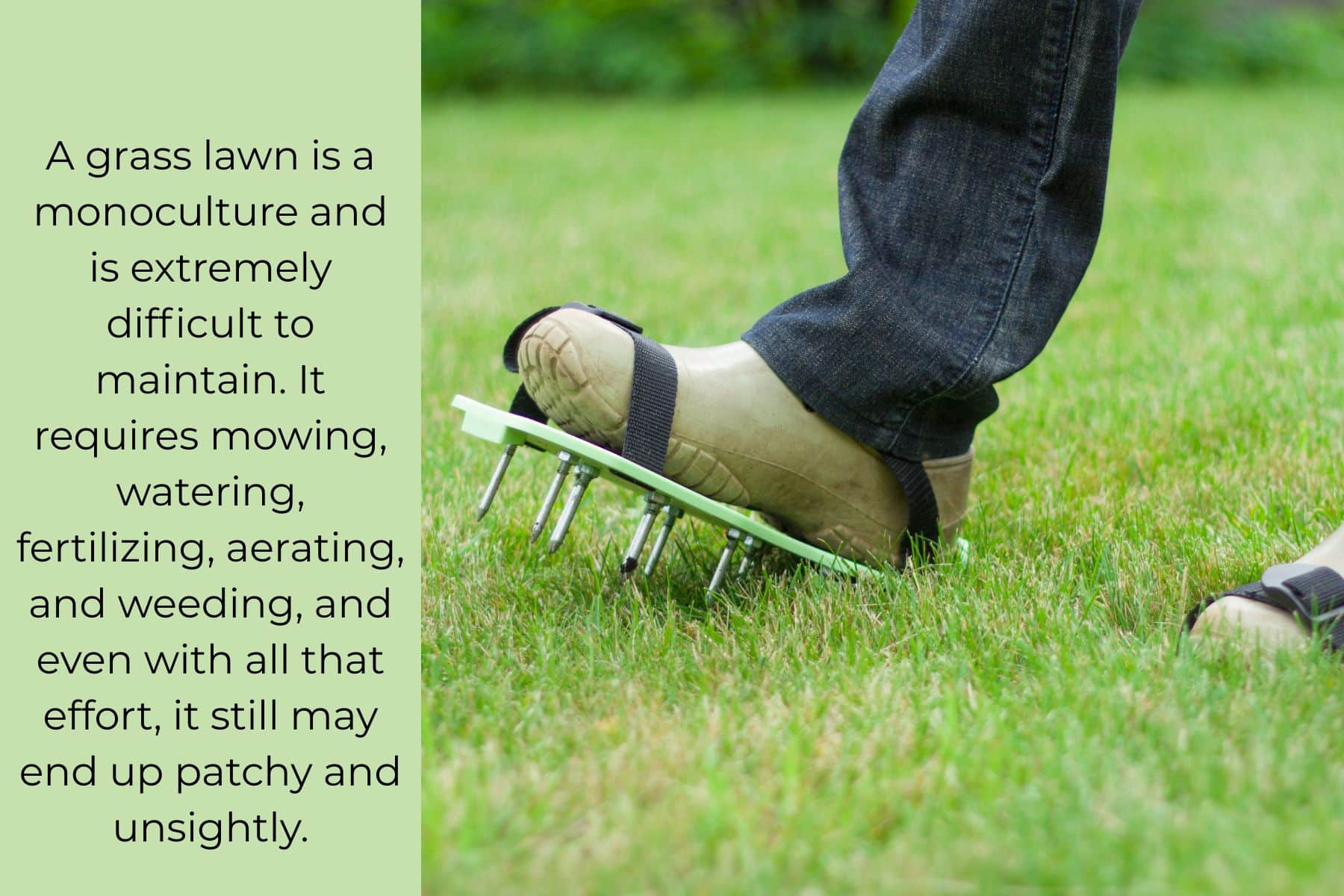
So when trying to go low-maintenance, the first thing you need to do is rethink monoculture. How can you add more diversity to your landscaping?
Here are some ideas:
- Plant shrubs
- Plant trees
- Allocate more areas for growing flowers, vegetables, and other non-grass plants
Overall, aim for a diverse array of plants with various heights, colors, and bloom times for the best results.
Finding Native Plants that Thrive in Pennsylvania’s Climate
It’s not just about diversity—the type of plants you choose matters a great deal. Where can you find low-maintenance plants that require minimal effort to thrive?
The key is native plants. When you plant things that are native to your area, those plants will naturally be low-maintenance—less watering, pruning, coaxing, etc—because they’re already adapted to thrive in your climate!
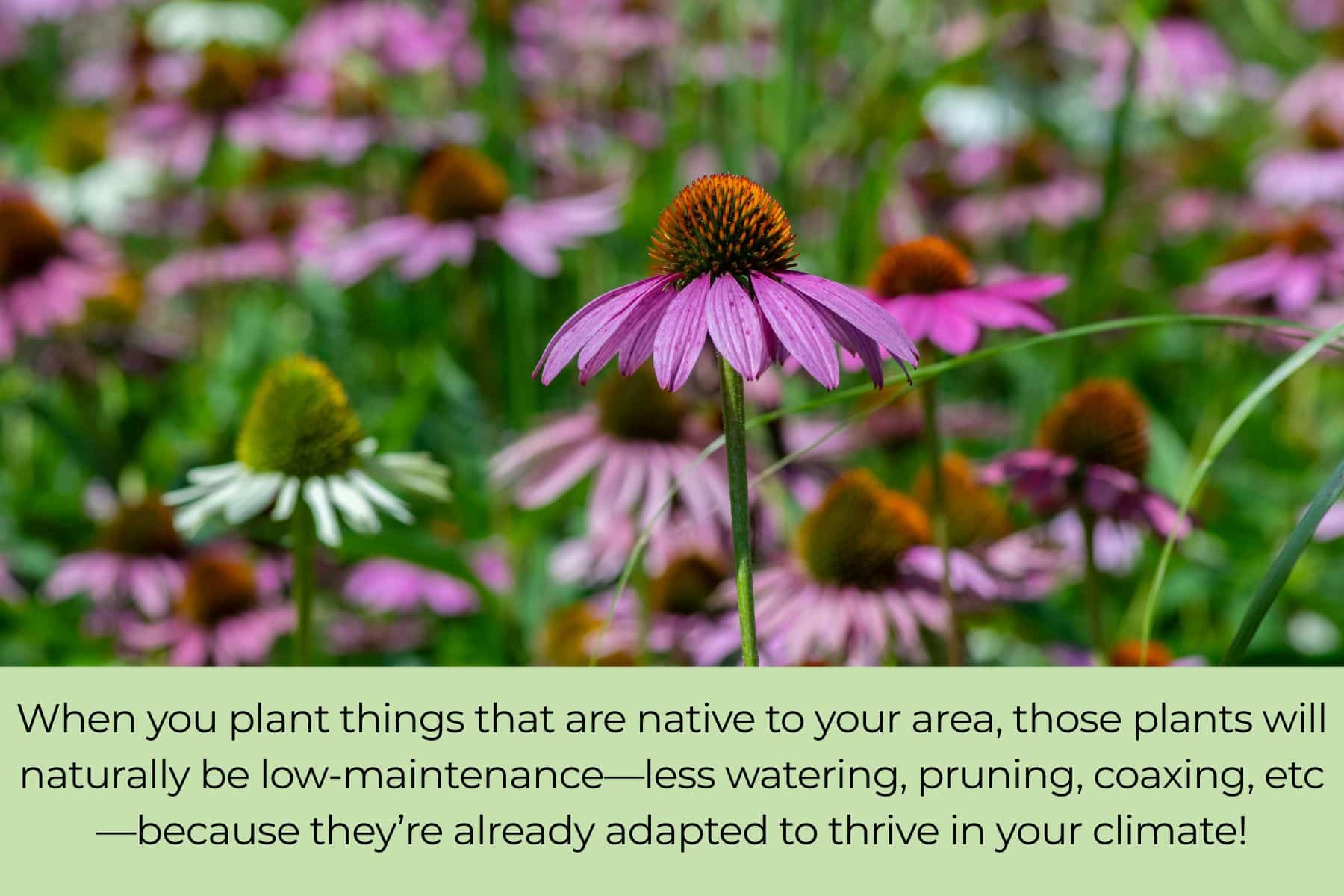
Although the possibilities are endless, here are a few ideas for native, low-maintenance plants to add diversity to your landscaping.
Trees
- Flowering Dogwood
- River Birch
- Red Maple
- Serviceberry
Shrubs
- Wygelea
- Hydrangeas
- Sweetspire
- Boxwood
Perennial Flowers
- Salvia
- Coreopsis
- Coneflower
- Liriope
Of course, this is only scratching the surface! For more ideas, check out:
Finally, when choosing plants, make sure to check what USDA Plant Hardiness Zone you’re in and how much sun your plants will get.
Other Tricks for Low-Maintenance Landscaping
The most important aspect of low-maintenance landscaping is choosing native plants, but there are also a few landscaping tricks you can use to help. These include:
Mulching
If you mulch deeply (2-3 inches) around plants, the mulch will retain water, reducing watering needs. It will insulate the soil, helping the soil microbiome and keeping your plants healthier. Mulch will also suppress weed growth.
Planting Densely
Dense ground cover gives less space for weeds to grow, and the shade from trees or shrubs will eventually help shade out weeds.
Hardscaping
Stone pathways, patios, and retaining walls are an aesthetically pleasing way to create areas you don’t have to weed, mow, or water. They’re also great ways to add functionality to your densely-planted outdoor spaces.
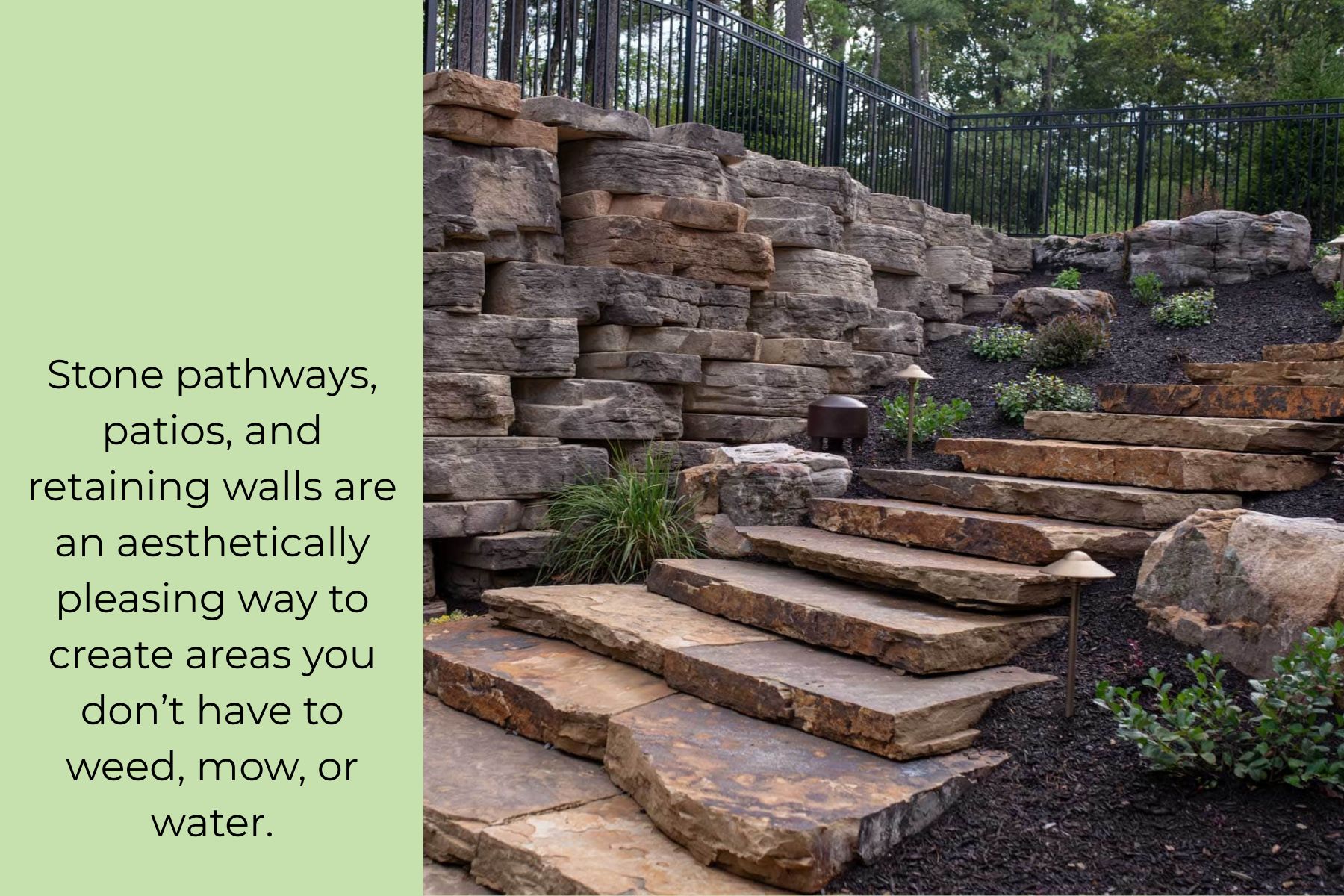
To learn more about your hardscaping options, check out our blogs on the subject!
When to Call in the Experts
If you love nothing more than to spend time outside puttering around your garden, you may relish the idea of picking out low-maintenance plants and re-designing your entire outdoor space.
But many of us are interested in low-maintenance landscaping precisely because we don’t have a lot of time to spend on our backyards.
If that’s the case for you, it might be worth it to hire an expert to redesign your landscaping. The perks for you include:
- Expert advice on what plants to choose. Remember—just because it seemed cool on the Internet doesn’t mean it’s a good idea! Professional landscapers are intimately familiar with the pros and cons of various plants.
- An aesthetically pleasing design. After all, it can be challenging to achieve the look you want as an amateur gardener or DIY enthusiast.
- A smooth ride. By paying a professional to do the landscape redesign for you, you can rest easy knowing that from now on, you won’t have to spend nearly as much time on landscaping maintenance.
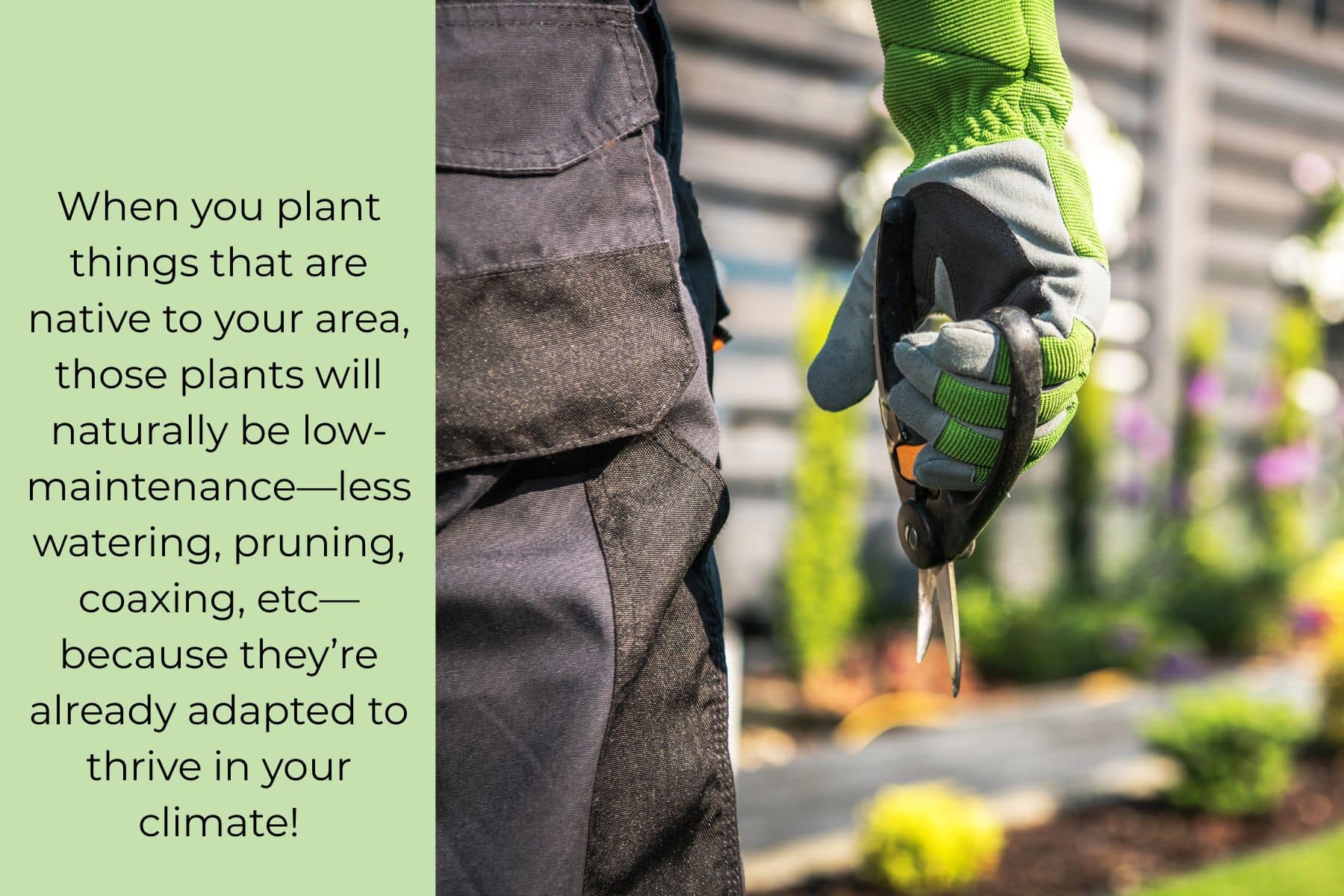
If you live in Altoona, State College, Johnstown, Bedford, or Hollidaysburg, Pennsylvania, Tussey Landscaping would love to help you with the low-maintenance landscaping design of your dreams!
Contact us today for a meaningful conversation about your landscaping vision.






